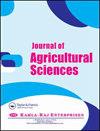Increasing of Phenolic Compounds by Brassinosteroid Applications in Immobilized Cell Suspension Cultures of Vitis vinifera L. cv. Cinsault
IF 0.7
Q3 AGRICULTURE, MULTIDISCIPLINARY
引用次数: 2
Abstract
In this paper, the effects on secondary metabolite accumulation of brassinosteroid (BR) (24-epibrassinolide (24-eBL) on immobilized cells that were obtained from Vitis vinifera cv. Cinsault was investigated. 24-eBL was applied to immobilized cells covered calcium alginate beads at concentrations of 0, 0.25, 0.50, 0.75 and 1.0 mg L-1 for one month. As a result of this study, it was found that 24-eBL applications modified secondary metabolite accumulation and had positive effects on secondary metabolite production if the suitable concentration was used. While the highest total phenolic, catechin, chlorogenic acid, and p-coumaric acid contents were found in immobilized cells applied 0.75 mg L-1 24-eBL, the highest epicatechin, quercetin, trans-resveratrol contents were obtained in immobilized cells applied 0.50 mg L-1 24-eBL and the highest gallic acid content was determined in immobilized cells applied 0.25 mg L-1 24-eBL. On the other hand, the highest 24-eBL concentration (1 mg L-1) had decreased the content of secondary metabolite compared to the control (0 mg L-1 24-eBL) except total phenolic and catechin content. To conclude, 0.50 and 0.75 mg L-1 24-eBL concentrations were the most suitable concentrations for immobilized cell culture to provide the highest secondary metabolite accumulation.油菜素内酯在葡萄固定化细胞悬浮培养中的应用神索
本文研究了油菜素类固醇(BR)(24-表油菜素内酯(24-eBL)对固定化葡萄细胞次生代谢产物积累的影响。对辛索进行了调查。24-eBL分别以0、0.25、0.50、0.75和1.0 mg L-1的浓度作用于覆盖海藻酸钙珠的固定化细胞一个月。本研究发现,24-eBL施用可改变次生代谢物的积累,在适当浓度下对次生代谢物的产生有积极影响。总酚、儿茶素、绿原酸和对香豆酸含量在0.75 mg L-1 24-eBL的固定化细胞中最高,表儿茶素、槲皮素、反式白藜芦醇含量在0.50 mg L-1 24-eBL的固定化细胞中最高,没食子酸含量在0.25 mg L-1 24-eBL的固定细胞中最高。另一方面,最高24-eBL浓度(1 mg L-1)与对照(0 mg L-1 24-eBL)相比,除总酚和儿茶素含量外,次生代谢物的含量均有所降低。综上所述,0.50和0.75 mg L-1 24-eBL浓度是固定化细胞培养的最佳浓度,可提供最高的次生代谢物积累。
本文章由计算机程序翻译,如有差异,请以英文原文为准。
求助全文
约1分钟内获得全文
求助全文
来源期刊

Journal of Agricultural Sciences
AGRICULTURE, MULTIDISCIPLINARY-
CiteScore
1.80
自引率
0.00%
发文量
0
 求助内容:
求助内容: 应助结果提醒方式:
应助结果提醒方式:


